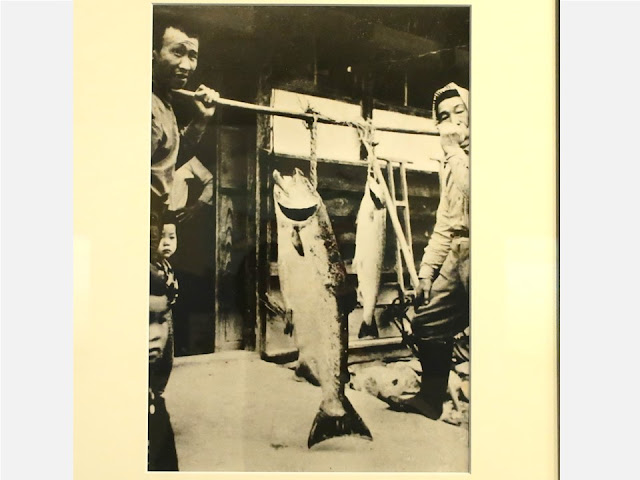The museum is in Murakami City which is in central Japan and on the Japan Sea coast. It is beside Miomote River in which salmons come every year. The museum shows us a lot of things about salmon such as fishing, eating, crafts and so on. Moreover, it is heart-warming that I know how Murakami people cherish salmon.
新潟県村上市にある鮭(イヨボヤ)の博物館です。鮭が遡る川のほとりにあり、鮭漁、食文化、鮭を使った工芸品まで様々なことが分かります。村上の人の鮭への愛を感じられ、暖かかったです。
A giant salmon above the entrance of the museum welcomes us.
入口の上にある巨大鮭の模型が出迎えてくれます。
A short movie named “The Miomote River: Story of Salmon” plays. Catching, eating, having a festival, and praying for the souls of salmons; they are grateful to the gift from the river. It’s very Japanese.
シアターでは、「三面川・サケの物語」が上演されています。サケの捕獲、食事、祭り、そして祈り。獲った魚をいただき感謝する、これが日本ですね。
The photo above shows how to catch salmons in Murakami. They set a long fence across the river and gather salmons to the cage (upper left).
村上では、主にウライ漁で鮭を獲っています。川幅いっぱいにウライを設置し、落とし柵(左上)に鮭を追い込みます。
It is said that fishing is a enjoyable work; it maybe right.
漁師の仕事は面白いと言いますが、そのようですねえ。
A king salmon was caught, which is worth of dishes for 125 people. I like their bragging faces. The photo was taken in 1958.
125人前の焼き付け料理ができたというマスノスケ(キングサーモン)(1958)。二人のドヤ顔がいいですね。
There is a spawning ground, which was preserved by the samurai (Aoto Buheiji) in the 18th century. He has been respected because he explained the importance of the spawning place and finally realized it. We can see the space from right beside. If you are lucky, you can watch an egg-laying in autumn. Salmons are fish to raise in Murakami.
三面川には、鮭の産卵スペースがあります。江戸時代の武士(青砥武平治)が作った種川です。種川確保の必要性を説いた彼は今も尊敬されています。イヨボヤ会館からは川の断面を見られるように工夫されていて、タイミングが合えば産卵シーンを見られるそうです。村上では、鮭は育てる魚です。
I walked an under pass and returned to the museum. There are many exhibits of salmon fishing. There is a full-scale model of a watchman's hut (lower right).
地下通路を経て資料館にもどると、さまざまな漁具が展示されていました。右下が番小屋の実物模型です。
There were more than ten watchman’s huts at the spawning space. They watched an illegal poaching and a facility condition. It’s a small hut, however watchmen enjoyed talking, eating and drinking while watching, I’m sure.
種川には、十数カ所の番小屋があって、密漁や設備破壊を監視していたといいます。内部は二、三畳ですが、番をしながら、会話や酒を楽しんだでしょうねえ。
The next section after fishing is about eating. There are more than one hundred salmon dishes in Murakami, and models of some of them are exhibited. The photos of Murakami in four seasons are displayed together.
次は、鮭を食べるコーナー。百を越える村上の鮭料理から、いくつかが模型が、村上の四季のパネルとともに展示されています。
Sake-bitashi is a specialty of Murakami, which is similar to a jerky. It is a sliced dried salmon after a year aging. It is soaked (bitasi) into sake (alcohol) and is tasted. I’ll show you its traditional factory in the last half of this article “Tourist spots in Murakami”.
酒びたしは当地の名物です。塩引き鮭を一年間乾燥・熟成させてからスライスし、酒に浸して食べます。この記事の後半、村上市内観光で紹介します。
Dried salmons are hung. Guts of a salmon are removed, then the body is salted. In Murakami, salt is removed around a week later, and it is dried.
村上の鮭は、内臓を取り除いて塩をした後、約一週間後に塩抜きし、数週間干し上げる「塩引き鮭」です。塩漬けで乾燥保存する新巻鮭と違います。
Following the salmon guides, I went to the 2nd floor.
鮭が二階へとガイドしてくれます。
There are exhibits about salmon and lifestyle.
二階の展示室では、鮭や生活にかかわる民俗展示があります。
Fishing gear for picking seaweeds: those are used mainly female divers.
海藻を採った海女さんたちの道具(上海府地区)
The coat was made from softened tree barks; it is a necessity for forestry work. I am surprised because the exhibit is very sophisticated.
藤蔓の樹皮を柔らかくして裂いて作った藤布織りは、山仕事に必要な作業着でした。展示品は上品すぎてびっくり。
Not only salmon but also ayu fishes so on are caught in the Miomote River; they are also cultivated. It's a rich river. Many fishing equipment is exhibited. The photo lower right is a lunch wooden box.
三面川では、鮎なども捕れます。養殖もします。漁具がたくさんありました。豊かな川です。右下はわっぱ弁当箱。
Salmon culture in Murakami、村上のサケ文化
Ebisu god on the left panel usually has a tai fish, but he has a salmon in Murakami. Artificial hatching of salmon is introduced on the right panel. The earnings are spent for scholarship; people who receive the grant is called “Salmon children”.
鯛を持つ恵比寿さんが、ここでは鮭を持っています(左パネル)。右のパネルでは、サケの人工ふ化事業とその収益をもとにした育英事業で勉学した人たちを「鮭の子」と呼んでいます。
The jacket, shoes, bags and so on are made from salmon skin. What a useful fish!
サケの皮を使ったジャケット、靴、かばんなど。とても有用な魚です。
Tourist spots in Murakami、村上市内観光
“Kikkawa” is the manufacturer and the seller of “Sake-bitashi”, which is similar to salmon jerky. Must-see movie is on their site below.
村上の名物「酒びたし」の製造販売の「きっかわ」さん。サイトの動画は必見です。
The retail space is at the roadside.
道路側は店です。
The photo above is salmon sushi, which is fermented around a month. It is made in many families even until now. It’s a culture of Murakami.
鮭の飯寿司、一ヶ月熟成させる馴れ寿司です。今も、多くの家庭で作られています。文化ですね。
Fresh fish market at Iwafune port、岩船港・鮮魚(せんぎょ)センター
At the wall of Murakami elementary school, there is a sign which declares that our education values the salmon culture. They love salmon so much.
市内中心部の小学校の看板には、鮭文化を大切にした学習と掲げられています。鮭を大切にする気持ちが伝わります。
Visited in October, 2022
Official website: https://www.iyoboya.jp/ (in Japanese),
accessed in January, 2023
Previous post (museum in the neighboring prefecture, Nagano): Karuizawa
Oiwakejuku Museum of Local、軽井沢町追分宿郷土館
Next post (Lifestyle and history museum in the same city): Murakami cultural history museum、村上歴史文化館




























Comments
Post a Comment